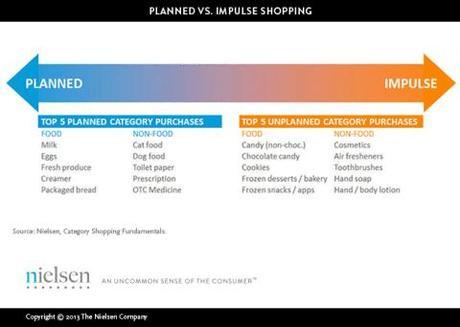The landscape is changing. We tend to shop everywhere we go and the shopper’s path to purchase is changing radically. There are many signs of the change. Amazon is now providing grocery delivery in select metro areas. Netflix is the darling of broadcast entertainment at the moment. Online sales and show rooming are the norm for any selling season. Just in time shopping is where it’s at. And men are growing in importance in weekly shopping.
So here’s some Shopportunities for Marketers in 2014 based on the new Nielsen Category Shopping Fundamentals study exploring the varied mindsets of today’s U.S. shoppers when it comes to making purchases for their everyday needs.
Planned vs. Impulse Shopping. Consumers plan to buy 72 percent of the category purchases that end up in their cart before they even head to the store. When you need toilet paper, a prescription refill and dog food, it’s not an impulse buy. However, that leaves 28% of purchases in the “shopportunity” category. They are the impulse category. Here’s a handy chart prepared by Nielsen.

Men Shopping More Often. Men just shop differently than women – they are less about the shopping experience. Men tend to shop functionally, planning purchases based on replenishment. They are less likely to focus on traditional promotions and coupons, which are effective with female shoppers. So the marketer’s job is to remind the male shopper he needs to replenish supplies. It seems that men also tend to pay more attention to in-store marketing intended to inform or attract purchases. It’s true in our household. I bet it is in yours as well.
Millennials Love Coupons. Millennials have been caught in a decade long budget squeeze. They are 1.6x more likely to be influenced by a coupon. The way offers are delivered are different. Millennials are looking online, taking advantage of loyalty groups and checking in with social sites like Foursquare to see if they are eligible for a coupon. And because the millennial is more open to new products, a coupon or promotional offer is a great way to invite trial.
Buying Loyalty. Some 82 percent of North Americans find money-saving deals worthy of their participation in loyalty groups. Beyond lower prices, respondents favored enhanced customer service (44%) and free shipping incentives (42%). Free shipping incentives are important to 46 percent.
Hispanic Shopping Influence Growing. Hispanics compose nearly 17 percent of the United States population and are among the nation’s fastest-growing demographic groups, according to the Census Bureau. And Hispanic buying power is creeping skyward as well. For instance, they do more grocery shopping than the average US consumer and they spend 20% more on routine trips. All this has made the Latino consumer extremely attractive. But one size marketing does not fit all. There are nuances that make it important to know your Hispanic market which will change by store and by region. Kmart and RoomsToGo are both using Sofia Vergara, star of the popular television show “Modern Family”, because she is one of the few that is authentically Latin American and part of mainstream culture. In addition, while Hispanics have traditionally been more price conscious, they can also be very brand loyal, and marketers need to know the facts.
Price Checking and Private Label. Shoppers are 40% more likely to price check when buying private label. U.S. shoppers do less price checking in-store and more coupon consideration pre-store when purchasing branded products, probably because of the preference and higher value of brands. However, private label is open to more price shopping.

